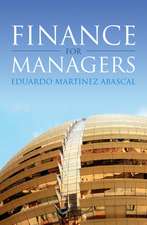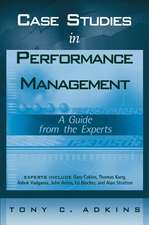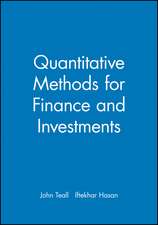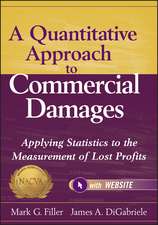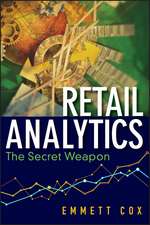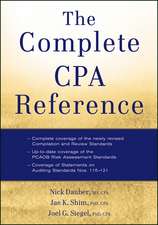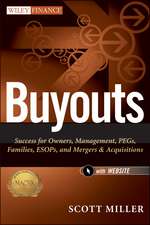Alternative Investments – An Allocator′s Approach – Fourth Edition
Autor CAIA Associatioen Limba Engleză Hardback – 7 oct 2020
Preț: 552.47 lei
Preț vechi: 690.59 lei
-20% Nou
Puncte Express: 829
Preț estimativ în valută:
105.73€ • 109.97$ • 87.28£
105.73€ • 109.97$ • 87.28£
Carte disponibilă
Livrare economică 24 martie-07 aprilie
Livrare express 07-13 martie pentru 78.75 lei
Preluare comenzi: 021 569.72.76
Specificații
ISBN-13: 9781119651680
ISBN-10: 1119651689
Pagini: 960
Dimensiuni: 186 x 260 x 53 mm
Greutate: 1.84 kg
Ediția:4th Edition
Editura: Wiley
Locul publicării:Chichester, United Kingdom
ISBN-10: 1119651689
Pagini: 960
Dimensiuni: 186 x 260 x 53 mm
Greutate: 1.84 kg
Ediția:4th Edition
Editura: Wiley
Locul publicării:Chichester, United Kingdom
Cuprins
Preface xxxix
Acknowlegements xli
About the Authors xlv
Part 1 Ethics Regulations and ESG
Chapter 1 Asset Manager Code 3
1.1 General Principles of Conduct 3
1.2 Asset Manager Code 3
1.3 Notification of Compliance 5
1.4 Additional Guidance for the Asset Manager Code 6
Chapter 2 Recommendations and Guidance 11
Chapter 3 Global Regulation 27
3.1 Overview of Financial Market Regulation 27
3.2 Regulation of Alternative Investments Within the United States 28
3.3 Alternative Investment Regulation in Europe 38
3.4 Hedge Fund Regulation in Asia 45
Chapter 4 ESG and Alternative Investments 49
4.1 Background on ESG and Alternative Investing 49
4.2 ESG and Real Assets: Natural Resources 51
4.3 ESG and Real Assets: Commodities 53
4.4 ESG and Real Assets: Real Estate 55
4.5 ESG and Hedge Funds 61
4.6 ESG and Private Equity 66
Chapter 5 ESG Analysis and Application 71
5.1 Background on ESG 71
5.2 ESG Ratings and Scores 73
5.3 ESG Materiality and Disclosure 74
5.4 The United Nations Role in ESG Issues 76
5.5 ESG Fiduciary Responsibilities and Regulation 78
5.6 Methods of ESG Investing 80
5.7 Market-Based Methods of Addressing ESG Issues 85
5.8 ESG and Special Investment Consideration 87
Part 2 Models
Chapter 6 Modeling Overview and Interest Rate Models 93
6.1 Types of Models Underlying Investment Strategies 93
6.2 Equilibrium Fixed-Income Models 96
6.3 Arbitrage-Free Models of the Term Structure 99
6.4 The Black-Derman-Toy Model 100
6.5 P-Measures and Q-Measures 103
Chapter 7 Credit Risk Models 105
7.1 The Economics of Credit Risk 105
7.2 Overview of Credit Risk Modeling 109
7.3 The Merton Model 110
7.4 Other Structural Models: KMV 117
7.5 Reduced-Form Models 120
7.6 Empirical Credit Models 123
Chapter 8 Multi-Factor Equity Pricing Models 127
8.1 Multi-Factor Asset Pricing Models 127
8.2 FAMA-French Models 131
8.3 Three Challenges of Empirical Multi-Factor Models 133
8.4 Factor Investing 135
8.5 The Adaptive Markets Hypothesis 141
8.6 Time-Varying Volatility 142
8.7 Stochastic Discount Factors 143
8.8 Summary of Multiple-Factor Asset Allocation 145
Chapter 9 Asset Allocation Processes and the Mean-Variance Model 147
9.1 Asset Allocation Processes and the Mean-Variance Model 147
9.2 Implementation of Mean-Variance Optimization 155
9.3 Mean-Variance Optimization with Multiple Risky Assets 160
9.4 Mean-Variance Optimization and Hurdle Rates 162
9.5 Issues in Using Optimization for Portfolio Selection 163
9.6 Adjustment of the Mean-Variance Approach for Illiquidity 166
9.7 Adjustment of the Mean-Variance Approach for Factor Exposure 168
9.8 Mitigating Estimation Error Risk in Mean-Variance Optimization 168
Chapter 10 Other Asset Allocation Approaches 175
10.1 The Core-Satellite Approach 175
10.2 Top-Down and Bottom-Up Asset Allocation Approaches 176
10.3 Risk Budgeting 178
10.4 A Factor-Based Example of Implementing A Risk Budgeting Approach 181
10.5 Risk Parity 183
10.6 Other Quantitative Portfolio Allocation Strategies 189
10.7 The New Investment Model 193
Part 3 Institutional Asset Owners and Investment Policies
Chapter 11 Types of Asset Owners and the Investment Policy Statement 197
11.1 Endowments and Foundations 197
11.2 Pension Funds 198
11.3 Sovereign Wealth Funds 199
11.4 Family Offices 199
11.5 Strategic Asset Allocation: Risk and Return 199
11.6 Asset Allocation Objectives 202
11.7 Investment Policy Constraints 202
11.8 Investment Policy Statements for Institutional Asset Owners 204
Chapter 12 Foundations and the Endowment Model 221
12.1 Defining Endowments and Foundations 221
12.2 Intergenerational Equity, Inflation, and Spending Challenges 224
12.3 The Endowment Model 226
12.4 Why Might Large Endowments Outperform? 228
12.5 Risks of the Endowment Model 234
12.6 Liquidity Rebalancing and Tactical Asset Allocation 239
12.7 Tail Risk 240
12.8 Conclusion 242
Chapter 13 Pension Fund Portfolio Management 245
13.1 Development, Motivations, and Types of Pension Plans 245
13.2 Risk Tolerance and Asset Allocation 247
13.3 Defined Benefit Plans 251
13.4 Governmental Social Security Plans 258
13.5 Contrasting Defined Benefit and Contribution Plans 259
13.6 Annuities for Retirement Income 262
13.7 Conclusion 266
Chapter 14 Sovereign Wealth Funds 269
14.1 Sources of Sovereign Wealth 269
14.2 Four Types of Sovereign Wealth Funds 272
14.3 Establishment and Management of Sovereign Wealth Funds 274
14.4 Governance and Political Risks of SWFs 277
14.5 Analysis of Three Sovereign Wealth Funds 279
14.6 Conclusion 282
Chapter 15 Family Offices and the Family Office Model 285
15.1 Identifying Family Offices 285
15.2 Goals, Benefits, and Business Models of Family Offices 286
15.3 Family Office Goals by Generations 290
15.4 Macroeconomic Exposures of Family Offices 295
15.5 Income Taxes of Family Offices 297
15.6 Lifestyle Assets of Family Offices 300
15.7 Family Office Governance 304
15.8 Charity, Philanthropy, and Impact Investing 307
15.9 Ten Competitive Advantages of Family Offices 310
Part 4 Risk and Risk Management
Chapter 16 Cases in Tail Risk 315
16.1 Problems Driven by Market Losses 315
16.2 Trading Technology and Financial Crises 324
16.3 Failures Driven by Fraud 326
16.4 Four Major lessons From cases in Tail Events 334
Chapter 17 Benchmarking and Performance Attribution 337
17.1 Benchmarking and Performance Attribution Overview 337
17.2 Single-Factor Benchmarking and Performance Attribution 340
17.3 Multi-Factor Benchmarking 344
17.4 Distinctions Regarding Alternative Asset Benchmarking 346
17.5 Benchmarking of Commodities 348
17.6 Three Approaches to Benchmarking Managed Futures Funds 351
17.7 Benchmarking Private Equity Funds 352
17.8 Group Peer Returns as Benchmarks 357
17.9 Benchmarking Real Estate 358
Chapter 18 Liquidity and Funding Risks 363
18.1 Margin Accounts and Collateral Management 363
18.2 Value at Risk for Managed Futures 367
18.3 Other Methods of Estimating Liquidity Needs 369
18.4 Smoothed Returns on Illiquid Funds 373
18.5 Modeling Price and Return Smoothing 375
18.6 Unsmoothing a Hypothetical Return Series 378
18.7 Unsmoothing Actual Real Estate Return Data 380
Chapter 19 Hedging, Rebalancing, and Monitoring 389
19.1 Managing Alpha and Systematic Risk 389
19.2 Managing the Risk of a Portfolio with Options 391
19.3 Delta-Hedging of Option Positions 394
19.4 Three Key Observations on Delta-Hedging 399
19.5 Three Observations on Rebalancing Delta-Neutral Option Portfolios 400
19.6 Rebalancing Portfolios with Directional Exposures 401
19.7 Mean-Reversion and Diversification Return 407
19.8 Investment Monitoring 409
Chapter 20 Risk Measurement, Risk Management, and Risk Systems 413
20.1 Overview of Risk Measurement and Aggregation 413
20.2 Categories of Information to be Considered 422
20.3 Risk Measurement with Daily Frequency of Data Collection 424
20.4 Risk Measurement with Weekly Frequency of Data Collection 425
20.5 Risk Measurement with Monthly Frequency of Data Collection 426
20.6 Risk Measurement with Quarterly Frequency of Data Collection 427
20.7 Risk Measurement with Annual Frequency of Data Collection or Rolling Time Periods 427
20.8 Cybersecurity for Fund Managers 429
20.9 Risk Management Structure and Process 432
Part 5 Methods for Alternative Investing
Chapter 21 Valuation and Hedging Using Binomial Trees 439
21.1 A One-Period Binomial Tree and Risk-Neutral Modeling 439
21.2 Multi-Period Binomial Trees, Values, and Mean Rates 442
21.3 Valuation of Convertible Securities with a Binomial Tree Model 445
21.4 Valuing Callable Bonds with a Tree Model 452
21.5 Tree Models, Visualization, and Two Benefits to Spreadsheets 458
Chapter 22 Directional Strategies and Methods 459
22.1 Efficiently Inefficient Markets 459
22.2 Technical Directional Strategies Overview 460
22.3 Fundamental Directional Strategies 467
22.4 Directional Strategies and Behavioral Finance 473
22.5 Directional Trading and Factors 476
Chapter 23 Multivariate Empirical Methods and Performance Persistence 479
23.1 Statistical Factors and Principal Component Analysis 479
23.2 Multi-Factor Models and Regression 483
23.3 Partial Autocorrelations and Regression 485
23.4 Three Dynamic Risk Exposure Models 487
23.5 Two Approaches to Modeling Changing Correlation 489
23.6 Four Multi-Factor Approaches to Understanding Returns 493
23.7 Evidence on Fund Performance Persistence 496
Chapter 24 Relative Value Methods 499
24.1 Overview of Relative Value Methods 499
24.2 Types of Pairs Trading and the Four Typical Steps 502
24.3 Statistical Pairs Trading of Equities 503
24.4 Pairs Trading in Commodity Markets Based on Spreads 506
Chapter 25 Valuation Methods for Private Assets: The Case of Real Estate 519
25.1 Depreciation Tax Shields 519
25.2 Deferral of Taxation of Gains 522
25.3 Comparing After-Tax Returns for Various Taxation Scenarios 524
25.4 Transaction-Based Indices: Repeat-Sales 529
25.5 Transaction-Based Indices: Hedonic 532
25.6 Sample Bias and the Repeat-Sales and Hedonic-Price Methods 535
25.7 Appraisal-Based Indices 536
25.8 Noisy Pricing 537
Part 6 Accessing Alternative Investments
Chapter 26 Hedge Fund Replication 543
26.1 An Overview of Replication Products 543
26.2 Potential Benefits of Replication Products 544
26.3 The Case for Hedge Fund Replication 545
26.4 Unique Benefits of Replication Products 549
26.5 Factor-Based Approach to Replication 552
26.6 The Algorithmic (Bottom-Up) Approach 558
26.7 Three Illustrations of the Algorithmic (Bottom-Up) Approach 558
Chapter 27 Diversified Access to Hedge Funds 565
27.1 Evidence Regarding Hedge Fund Risk and Returns 565
27.2 Approaches to Accessing Hedge Funds 569
27.3 Characteristics of Funds of Hedge Funds 573
27.4 Fund of Hedge Funds Portfolio Construction 577
27.5 Ways that Funds of Hedge Funds Can Add Value 580
27.6 Investable Hedge Fund Indices 584
27.7 Alternative Mutual Funds 585
Chapter 28 Access to Real Estate and Commodities 589
28.1 Unlisted Real Estate Funds 589
28.2 Listed Real Estate Funds 594
28.3 Commodities 598
28.4 Commodity Trade Financing and Production Financing 606
28.5 Leveraged and Option-Based Structured Commodity Exposures 606
28.6 Key Concepts in Managing Commodity Exposure 609
Chapter 29 Access Through Private Structures 613
29.1 Overview of Issues in Private Versus Listed Investment Access 613
29.2 Unlisted Manager-Investor Relationships 616
29.3 Side Letters to Limited Partnership Agreements 619
29.4 Co-Investments 621
29.5 Cash Commitments and Illiquidity 626
29.6 The Secondary Market for PE Partnerships 629
Chapter 30 The Risk and Performance of Private and Listed Assets 637
30.1 Evidence on an Illiquidity Premium from Listed Assets 637
30.2 Private Versus Listed Real Performance: The Case of Real Estate 639
30.3 Challenges with the PME Method to Evaluating Private Asset Performance 641
30.4 Multiple Evaluation Tools 648
30.5 IRR Aggregation Problems for Portfolios 653
30.6 The Case Against Private Equity 657
30.7 Two Propositions Regarding Access Through Private Versus Listed Structures 658
Part 7 Due Diligence & Selecting Managers
Chapter 31 Active Management and New Investments 663
31.1 Tactical Asset Allocation 663
31.2 The Fundamental Law of Active Management 664
31.3 Costs of Actively Reallocating Across Alternative Investments 667
31.4 Keys to a Successful Tactical Asset Allocation Process 670
31.5 Adjusting Exposures to Illiquid Partnerships 674
31.6 The Secondary Market for PE LP Interests 676
Chapter 32 Selection of a Fund Manager 683
32.1 The Importance of Fund Selection Across Managers Through Time 683
32.2 The Relationship Life Cycle Between LPs and GPs 683
32.3 Fund Return Persistence 688
32.4 Moral Hazard, Adverse Selection, and the Holdup Problem in Fund Management 694
32.5 Screening with Fundamental Questions 694
32.6 Historical Performance Review 698
32.7 Manager Selection and Deal Sourcing 703
32.8 Fund Culture 705
32.9 Decision-Making and Commitment and Manager Selection 706
Chapter 33 Investment Process Due Diligence 709
33.1 Overview of Investment Due Diligence 709
33.2 The Investment Strategy or Mandate 712
33.3 The Investment Implementation Process and its Risks 715
33.4 Asset Custody and Valuation 717
33.5 Risk Alert's One Advantage and Six Observations on Third-Party Information 723
33.6 Portfolio Risk Review 725
33.7 Four Warning Indicators and Awareness Signals Regarding Investments 729
33.8 Four Warning Indicators and Awareness Signals Regarding Risk Management 729
Chapter 34 Operational Due Diligence 731
34.1 Operations: Overview, Risks, and Remedies 731
34.2 Four Key Operational Activities 735
34.3 Analyzing Fund Cash Management and Movement 737
34.4 Analyzing External Parties and Checking Principals 739
34.5 Analyzing Fund Compliance 743
34.6 Onsite Manager Visits 747
34.7 Elements and Key Concerns of the Odd Process 748
34.8 Information Technology and Meta Risks 749
34.9 Funding, Applying, and Concluding ODD 750
Chapter 35 Due Diligence of Terms and Business Activities 755
35.1 Due Diligence Document Collection Process 755
35.2 Fund Governance 757
35.3 Structural Review of the Fund And Fund Manager 758
35.4 Terms for Liquid Private Funds 761
35.5 Terms for Illiquid Private Funds 763
35.6 General Terms for Private Funds 764
35.7 Private Placement Memorandum (PPM) 765
35.8 Fund Fees and Expenses 769
35.9 Private Fund Audited Financial Statement Review 771
35.10 Business Activities, Continuity Planning, Disaster Recovery, and Insurance 773
Part 8 Volatility and Complex Strategies
Chapter 36 Volatility as a Factor Exposure 779
36.1 Measures of Volatility 779
36.2 Volatility and the Vegas, Gammas, and Thetas of Options 781
36.3 Exposures to Volatility as a Factor 785
36.4 Modeling Volatility Processes 791
36.5 Implied Volatility Structures 794
Chapter 37 Volatility, Correlation, and Dispersion Products and Strategies 799
37.1 Common Option Strategies and their Volatility Exposures 799
37.2 Volatility and Delta-Neutral Portfolios with Options 803
37.3 Advanced Option-Based Volatility Strategies 805
37.4 Variance-Based and Volatility-Based Derivative Products 807
37.5 Correlation Swaps 815
37.6 Dispersion Trades 818
37.7 Summary and Common Themes of Volatility, Correlation, and Dispersion Trading 819
Chapter 38 Complexity and Structured Products 825
38.1 Uncertainty, Ambiguity, and Opacity 825
38.2 Asset and Strategy Complexity 827
38.3 Cases in Complexity and Perverse Incentives 828
38.4 Asset-Based Lending 831
38.5 Risks of Asset-Based Loans 836
38.6 Asset-Backed Securities 838
Chapter 39 Insurance-Linked Products and Hybrid Securities 845
39.1 Nonlife ILS: Catastrophe Bonds 845
39.2 Four Trigger Types of Cat Bonds 847
39.3 Cat Bond Valuation, Performance, and Drawbacks 849
39.4 Longevity and Mortality Risk-Related Products 852
39.5 Life Insurance Settlements 855
39.6 Overview of Viatical Settlements 857
39.7 Hybrid Products: Mezzanine Debt 859
Chapter 40 Complexity and the Case of Cross-Border Real Estate Investing 865
40.1 Traditional View of Currency-Hedging for Cross-Border Real Estate Investing 865
40.2 Fundamentals of Currency Risk And Hedging in Perfect Markets 870
40.3 Currency Risk and Hedging of Alternative Investments 873
40.4 Accessing Foreign Assets with Futures and Quanto Futures 876
40.5 Overview of International Real Estate Investing 879
40.6 Heterogenous Investment Taxation Across Jurisdictions 881
40.7 Challenges to International Real Estate Investing 882
Index 887
Notă biografică
DR. DONALD R. CHAMBERS, PhD, CAIA, is Associate Director of Programs at the CAIA Association; Chief Investment Officer of Biltmore Capital Advisors and Emeritus Professor at Lafayette College in Easton, Pennsylvania. Dr. Chambers previously served as Director of Alternative Investments at Karpus Investment Management. He is a member of the editorial board of The Journal of Alternative Investments.
DR. HOSSEIN KAZEMI, PhD, is a senior adviser to the CAIA Association. He is the Michael and Cheryl Philipp Professor of Finance at the University of Massachusetts, Amherst; Director of the Center for International Securities and Derivatives Markets; a cofounder of the CAIA Association; and Editor-in-Chief of The Journal of Alternative Investments-the official publication of the CAIA Association and a member of the editorial board of The Journal of Financial Data Science.
DR. KEITH H. BLACK, PhD, CAIA, FDP, is the Managing Director of Content Strategy at the CAIA Association. He was previously an associate at Ennis Knupp and, before that, an assistant professor at Illinois Institute of Technology. He is a member of the editorial board of The Journal of Alternative Investments.


